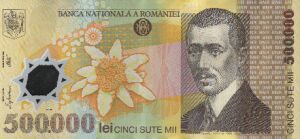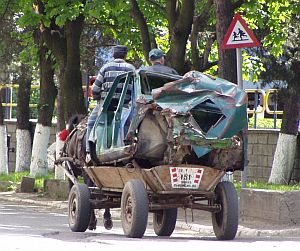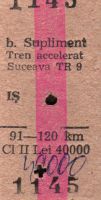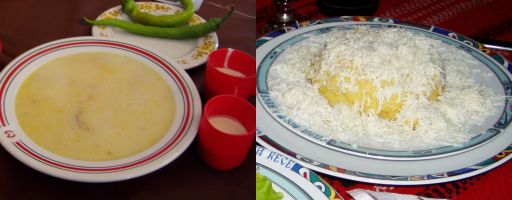Prologue
So far I've been to Romania three times. The first time didn't really convince me - but that was probably due to the lousy weather and the choice of places - Brasov and Bucharest. The second trip was much better, and the third (shortly after the second) made me a real fan of the country. Romania appeared to be a great destination with plenty to see and very nice people. I was glad that I went back to see more despite the outcome of the first trip.
Visa
Romania substantially relaxed its rigid visa policy a few years ago. Most (or all!?) EU citizens and Americans do not require a visa any longer. A valid passport is everything you need. Other nationalities still seem to require a visa, but a letter of invitation is not necessary.
Money
The Romanian currency is called Leu (Plural: Lei). Many years ago, one Leu consisted of 100 Bani, but due to the inflation the Bani has vanished. In summer 2004, the average exchange rate was € 1 = 40,500 Lei. The inflation rate is very low now, so the rate won't change as much as it did years ago. There are three coins with a 500, 1000 and 5000 Lei denomination. Notes come in 2,000, 10,000, 50,000, 100,000 and 500,000 (haven't seen anything higher) Lei denominations. But - the Romanian Leu has been revaluated in Summer 2005: 4 zeros were cut, but besides this the paper money didn't change much of its appearance. Old money remains valid until the end of 2006. The recent exchange rate (again, very stable!) is € 1 = 3.5 Lei.

| ||
| Sophisticated Romanian 500,000 Lei note |
All notes are highly sophisticated and have state-of-the-art security features: Most modern polymers with a small, transparent window (quite similar to Australian, New Zealand etc money). As if the government would suspect their citizens of having a colour copier in each household! In all bigger cities, ATM's accepting all the usual credit cards and Maestro, Cirrus etc cash cards a quite common. The usual fee per transaction is € 4.
Attention: It's almost impossible to change Romanian money outside Romania. Some exchange booths in →Sofia accept Romanian Lei, but the rate is rather poor. Things even look worse in →Budapest. Romanian Lei can be changed in Hungarian cities near the border (eg →Debrecen etc), but the rate is quite bad, too. Thus, it's better to spend or change spare Lei in Romania before you leave.
Costs
Romania is (still!?) a very cheap destination for travelers. Accommodation in plain but mostly clean hotels or pensions is mostly around € 10 per person in a double room. Self-catering is not really necessary unless you're planning to hike in remote areas, since eating out in normal restaurants rarely costs more than 2 or 3 Euro. The same can be said about travelling by train. To give an example, a single ticket for the express train (rapid) from Braşov to Bucharest will set you back € 5 only. Taxis are quite inexpensive, too: In Bucharest, there's a fixed fare of 4 Lei for the first few kilometres, which is usually enough for most rides in the city. In other cities, the regular fare is usually between 0.6 and 0.9 Lei per kilometer. Usually, the price per kilometer is printed on the driver's door. However, some taxis do not have a meter or drivers 'forget' to switch it on. Hence, it's better to check beforehand. If there's no meter, agree on the fare before you start. If it's a longer distance, it's definitely worth haggling a little bit.
If you don't need luxury but fancy a nice meal and extensive sightseeing, you will easily get by on € 30 a day (incl. train tickets and everything). Self-caterer (groceries are omnipresent, open until late at night and are called Alimentare) bringing their own tent will easily get by on € 10 per day or less. By the way, a beer in a restaurant or bar usually costs around 1.5 Lei (€ 0.4) a pint.
Getting there
By bus, train, boat or plane - everything's possible. And except for the →Ukraine and →Moldova, most nationalities do not require a visa for the neighbouring countries. There are many direct flights from all major European airports. The main airport in the country is Otopeni Int'l Airport 17 km north of the capital.

| ||
| Don't worry if your car is broken... |
There are also numerous direct buses from all major cities in Middle Europe. However, spending more than 24 hours on the bus and passing several border crossings is not everyone's cup of tea. Still, buses are the easiest way to get there (apart from hitchhiking of course).
A more relaxed and interesting way is to get there by train. Unfortunately, there are no direct connections from Western Europe. It's necessary to change trains either in Vienna or in →Prague respectively →Budapest. So far there's no discount ticket available for Romania. And so the fare for a single ticket from Germany to Braşov via Dresden and →Prague costs around € 140, incl. the fee for the sleeper. The trip takes more than 24 hours, but it's a relaxed train ride. When coming from another European country, it's much cheaper to travel from border to border, crossing the border on a local train. Of course this is very time-consuming. The German railway company offers so-called Spar-Night tickets - from Germany to →Budapest, the price for a return ticket on a sleeper is € 98, but it's necessary to book in advance. From Budapest to the Romanian border, it's € 8 only.
Austria offers CityStar-Tickets, which are a good bargain, too. There's no discount ticket for Romania, but it's cheap to go like this via →Hungary or →Serbia. According to several reports, traveling the country by car can still be dangerous - some people talk about muggings, police arbitrariness, accident fraud etc. Personally I think that the situation has improved a lot and streets are pretty safe. However, traffic in the capital is just gruelling, not to say a pure nightmare, and this won't change over the next years.
Border crossings
Nothing is easier than crossing the border to Romania: Most border guards are very friendly, almost no or at least no strict luggage control is applied and there are large boards everywhere saying that corruption is strictly forbidden etc. There are also useful telefon numbers where travelers can complain. Many years ago, crossing the border to Romania was nightmarish - even for humanitarian aid workers. Today it's a piece of cake. There are numerous border crossings to the neighbouring countries. However, some of the border crossings to the →Ukraine are for locals only - only one crossings can be used by travelers (that's the one near →Suceava.
Transportation in Romania
You can get around by bus, train or plane. Since large parts of the country are mountaineous, it can take a while to get from A to B.

| ||
| Train ticket |
Of course, the fastest way to get around is the airplane. There are numerous national flights. The fastest and therefore most expensive train is called InterCity, but connections are limited. Less fast are the so-called rapid/expres trains. The most common one is the characteristic light-blue accelerat. All of these trains require a seat reservation. Since many train stations do not have computers, free seats need to be passed on via the telephone. This again means that it's often not possible to buy tickets more than 1 hour ahead. A double reservation for the same seat is quite common, too. Although accelerats often need more than 12 hours to get from one part of the country to another, there's no restaurant or buffet on the train. Therefore it's wise to buy food and drinks at the train station.
Local trains are called personal. They cost only half the price of the accelerat, but they are incredibly slow and often overcrowded. Personals stop at every tree, and they often wait 10 minutes or so for faster trains to pass by. Attention: Usually, departure times (plecare) and arrival times (sosire) are written on the same timetable, which can be very confusing. Note that there aren't many trains crossing the border. If you see two large towns on the map - one in Romania, the other one in a neighbouring country - connected by a railway line, it doesn't necessarily mean that there are trains. And so it can become very tricky to get from →Satu Mare to →Debrecen for example.
Buses are only helpful if there's no train connection. Local buses are often slow and dirty; long distance buses are not much better. You can stop most buses everywhere you like. Which is very convenient, but on the other hand it means that it can take hours to cover 100 km or so. In most towns, the autogară (bus station) can be found somewhere near the train station (unless the train station is far away from the centre).
Food and drinks
Well, Romanian food can be quite tasty, but after a week or so of Romanian food only I'm starting to yearn for something else (my opinion). Quite famous and omnipresent is the so-called Ciorbâ de Burtâ, which is a white, slightly sour tripe soup. Definitely not everyone's cup of tea!

| ||
| Ciorbâ de Burtâ (left) and Mâmâligâ & Brânză |
Another popular dish and very typical for the area is called Mititei - grilled minced meat, sometimes served with a tasty cream souce. In many other countries on the Balkan they are known as Čevapčiči. The main side dish is the Mâmâligâ, which is a yellow corn mush, sometimes served with a sauce but quite often topped with Brânză (salty sheep's cheese). If you've had enough of grilled meat, you may stick to the tasty caşcaval pane - hot, breaded cheese as it can be found everywhere between Prague and Sofia. Talking about breaded food - Creier pane, breaded brains, is a standard dish as well.
In restaurants, waiters always ask if you want some Pâine (also Pîine) (white bread) with your meal. It costs a few Lei extra. After a couple of days with Mâmâligâ and/or Cartofi (potatoes, mostly fried), you might want to try one of the many Italian restaurants. Recently they've mushroomed everywhere, in some towns they even outnumber Romanian restaurants. Some of them are lousy, others are really excellent. Note that the sign 'restaurant' doesn't always mean that there's food - sometimes it's just a simple bar serving drinks only!
Romania is quite famous for its vin (wine), as for example Murfartlar. Beer is quite common as well - especially the brand Skol can be recommended. And there are numerous types of firewater - probably the most famous one is called Ţuică (plum brandy), others include Raki (usually made of grapes) and others. Vodka is popular, too - there's a brand called "Stalinskaya", but this is better to be avoided. The South Bukovina is well known for its fine cherry and other liquors (see also →Suceava). Coffee is often boiled with suggar and therefore very sweet. Espresso and coffee (cafea) are standard today (which wasn't always like that). However, the further you go to the west, the better the coffee is.
©2024 Europe-East.com

 Albania
Albania Romania
Romania